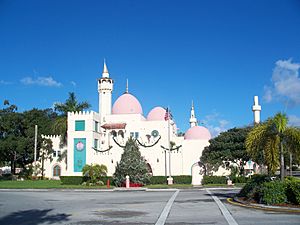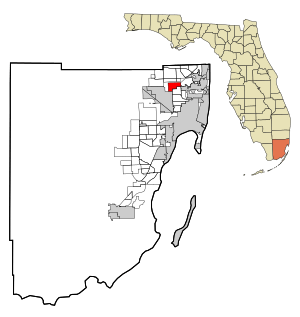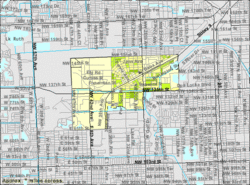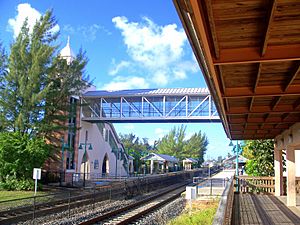Opa-locka, Florida facts for kids
Quick facts for kids
Opa-locka, Florida
Opa-tisha-wocka-locka (Seminole)
|
||
|---|---|---|
| City of Opa-locka | ||

Opa-locka City Hall
|
||
|
||

Location in Miami-Dade County and the state of Florida
|
||

U.S. Census Bureau map showing city limits
|
||
| Country | ||
| State | ||
| County | ||
| Incorporated | May 14, 1926 | |
| Government | ||
| • Type | Council-Manager | |
| Area | ||
| • Total | 4.48 sq mi (11.61 km2) | |
| • Land | 4.31 sq mi (11.16 km2) | |
| • Water | 0.17 sq mi (0.45 km2) 3.13% | |
| Elevation | 7 ft (2 m) | |
| Population
(2020)
|
||
| • Total | 16,463 | |
| • Density | 3,821.49/sq mi (1,475.60/km2) | |
| Time zone | UTC−5 (EST) | |
| • Summer (DST) | UTC−4 (EDT) | |
| ZIP Codes |
33054, 33014 (Hialeah)
|
|
| Area code(s) | 305, 786, 645 | |
| FIPS code | 12-51650 | |
Opa-locka is a city in Miami-Dade County, Florida, United States. It's part of the larger Miami metropolitan area in South Florida. In 2020, about 16,463 people lived there.
This unique city was started in 1926 by Glenn Curtiss, who was an American aviator and businessman. He was inspired by the famous Middle Eastern stories from One Thousand and One Nights. Because of this, Opa-locka has many buildings with a special Moorish Revival architecture style. You'll also find street names like Sharazad Boulevard and Ali Baba Avenue!
The name Opa-locka comes from a Seminole phrase, Opa-tisha-wocka-locka. It means "wooded hummock" or "a big island covered with many trees and swamps."
Contents
History of Opa-locka
Founding and Unique Architecture
Opa-locka was founded in 1926 by Glenn Curtiss, a pioneer in aviation. He designed the city with a special Moorish architecture theme. Even though a big hurricane in 1926 caused a lot of damage, many of these unique Moorish-style buildings survived. In fact, twenty of these original buildings are now listed on the National Register of Historic Places.
Famous Flights and Visitors
Amelia Earhart, a very famous pilot, started her historic trip around the world from Miami Municipal Airport. This airport was just south of Opa-locka. Also, the famous German airship Graf Zeppelin used to visit Naval Air Station Miami, which later became Opa-locka Airport. It was a regular stop on its trips between Germany, Brazil, and the United States.
Renaming a Street
On February 17, 2009, Opa-locka became the first community in the United States to honor the first African-American President. A section of Perviz Avenue was renamed Barack Obama Avenue.
City Features and Filming Locations
Besides its unique buildings, Opa-locka has a large airport for smaller planes, three parks, and two lakes. It also has a train station that is part of the Tri-Rail system. The city has a mix of homes, businesses, and industrial areas. Opa-locka has even been a backdrop for movies like Bad Boys II and 2 Fast 2 Furious.
Financial Challenges
In 2016, the city of Opa-locka faced some financial challenges. The Governor of Florida, Rick Scott, declared a "Financial Emergency" to help the city. This meant the state government would work with the city to manage its money better and help it recover. A special board was created to guide the city's financial decisions.
Opa-locka Airports
Miami Municipal Airport
Amelia Earhart began her famous flight around the world from Miami Municipal Airport. This airport was created by the city's founder, Glenn Curtiss, and was located in what is now the southern part of Opa-locka.
Opa-locka Executive Airport
The German airship Graf Zeppelin used to visit Naval Air Station Miami. This air station later became Opa-locka Airport. It was a regular stop on its scheduled routes.
In the 1950s, Opa-locka Airport was used for important government operations. For example, it was a base for activities related to Cuba during the Cuban Missile Crisis. Today, it is known as Opa-locka Executive Airport.
Geography of Opa-locka
Opa-locka is located at 25°54′06″N 80°15′03″W.
The United States Census Bureau says the city covers about 4.5 square miles (11.6 square kilometers). Most of this area, about 4.3 square miles (11.16 square kilometers), is land. The rest, about 0.1 square miles (0.45 square kilometers), is water.
Population and People
| Historical population | |||
|---|---|---|---|
| Census | Pop. | %± | |
| 1930 | 339 | — | |
| 1940 | 497 | 46.6% | |
| 1950 | 5,271 | 960.6% | |
| 1960 | 9,810 | 86.1% | |
| 1970 | 11,902 | 21.3% | |
| 1980 | 14,460 | 21.5% | |
| 1990 | 15,283 | 5.7% | |
| 2000 | 14,951 | −2.2% | |
| 2010 | 15,219 | 1.8% | |
| 2020 | 16,463 | 8.2% | |
| U.S. Decennial Census 2010 2020 |
|||
Opa-locka is home to a diverse community. Here's a look at the different groups of people who live there:
| Race / Ethnicity (NH = Non-Hispanic) | Pop 2010 | Pop 2020 | % 2010 | % 2020 |
|---|---|---|---|---|
| White (NH) | 323 | 317 | 2.12% | 1.93% |
| Black or African American (NH) | 9,336 | 8,227 | 61.54% | 49.97% |
| Native American or Alaska Native (NH) | 21 | 15 | 0.14% | 0.09% |
| Asian (NH) | 27 | 40 | 0.18% | 0.24% |
| Pacific Islander or Native Hawaiian (NH) | 1 | 2 | 0.01% | 0.01% |
| Some other race (NH) | 21 | 66 | 0.14% | 0.40% |
| Mixed race or Multiracial (NH) | 82 | 192 | 0.54% | 1.17% |
| Hispanic or Latino (any race) | 5,378 | 7,604 | 35.34% | 46.19% |
| Total | 15,219 | 16,463 | 100.00% | 100.00% |
Population in 2020
According to the 2020 United States census, there were 16,463 people living in Opa-locka. There were 5,534 households and 3,607 families.
Population in 2010
In the 2010 United States census, Opa-locka had 15,219 people. There were 5,843 households and 3,406 families.
Life in Opa-locka (2000 Census)
In 2000, about 41.2% of households had children under 18. The average household had about 3 people, and families averaged about 3.5 people. The median age in the city was 27 years old.
Most people in Opa-locka speak English as their first language (68.45%). A significant number also speak Spanish (28.30%) and French Creole (2.78%).
Education in Opa-locka
The Miami-Dade County Public Schools system serves students in Opa-locka.
- Dr. Robert B. Ingram/Opa-locka Elementary School is located right in the city.
- North Dade Middle School in Miami Gardens serves middle school students.
- Hialeah/Miami Lakes Senior High in Hialeah serves high school students.
Opa-locka Library
The Opa-locka Branch library is part of the Miami-Dade Public Library System. It offers programs for children, like an After School Club and Storytime, during the weekdays.
Religion in Opa-locka
In 1996, Opa-locka had 30 places of worship. One reporter from the Miami New Times even said that "Like South Beach has hotels, Opa-locka has churches." This shows how many different religious communities are present in the city.
Transportation in Opa-locka
Opa-locka has several ways to get around:
- Opa-locka Executive Airport: This airport is for general aviation and is managed by the Miami-Dade County Aviation Department.
- Miami-Dade Transit: Buses from this system serve the city.
- Tri-Rail: You can also use the Tri-Rail commuter train at the Opa-locka Station.
Notable People from Opa-locka
Many interesting people have come from Opa-locka, including:
- Brisco, a rapper
- Harry Wayne Casey, a singer
- Dalvin Cook, an NFL football player
- Rohan Davey, an NFL football player
- Thad Lewis, an NFL football player
- Montel Vontavious Porter, a professional wrestler
- Aurin Squire, a playwright
|
See also
 In Spanish: Opa-locka para niños
In Spanish: Opa-locka para niños





